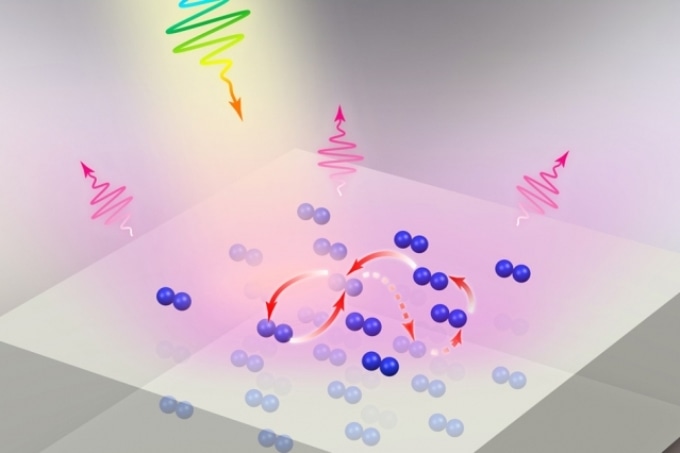Sep 19 2017
Two-dimensional (2D) materials known as molecular aggregates are extremely effective light emitters that function on a different principle than usual organic light-emitting diodes (OLEDs) or quantum dots.
But their prospect as components for new kinds of optoelectronic devices has been restricted by their comparatively slow response time. At present, Researchers at MIT, the University of California at Berkeley and Northeastern University have discovered a way to get around that limitation, potentially paving the way for a variety of applications for these materials.
 In this image, light strikes a molecular lattice deposited on a metal substrate. The molecules can quickly exchange energy with the metal below, a mechanism that leads to a much faster response time for the emission of fluorescent light from the lattice. (Courtesy of the researchers)
In this image, light strikes a molecular lattice deposited on a metal substrate. The molecules can quickly exchange energy with the metal below, a mechanism that leads to a much faster response time for the emission of fluorescent light from the lattice. (Courtesy of the researchers)
The research findings have been described in the journal Proceedings of the National Academy of Sciences, in a paper by MIT Associate Professor of Mechanical Engineering Nicholas X. Fang, Postdocs Qing Hu and Dafei Jin, and five others.
The key to improving the response time of these 2D molecular aggregates (2DMA), Fang and his team discovered, is to combine that material with a thin layer of a metal such as silver. The interaction between the 2DMA and the metal that is only a few nanometers away increases the speed of the material’s light pulses over tenfold.
These 2DMA materials display a variety of uncommon properties and have been used to form exotic types of matter, known as Bose-Einstein condensates, at room temperature, while other methods required extreme cooling. They have also been applied in technologies such as light-harvesting organic antennas and solar cells. But the latest work for the first time identifies the strong impact that a very close sheet of metal can have on the way these materials discharge light.
For these materials to be beneficial in devices such as photonic chips — which are like semiconductor chips but carry out their operations using light instead of electrons — “the challenge is to be able to switch them on and off quickly,” which had not been possible earlier, Fang says.
With the metal substrate close by, the response time for the light discharge reduced from 60 picoseconds (trillionths of a second) to just 2 picoseconds, Fang says,“This is pretty exciting, because we observed this effect even when the material is 5 to 10 nanometers away from the surface,” with a spacing layer of polymer in between. That is adequate separation for fabricating such paired materials in quantity without an excessively challenging process.
This is something we think could be adapted to roll-to-roll printing.
Associate Professor Nicholas X. Fang, Mechanical Engineering, MIT
If used for signal processing, such as transmitting data by light instead of radio waves, Fang says, this progress could lead to a data transmission rate of around 40 GHz, which is eight times faster than such devices can presently deliver. This is, “a very promising step, but it’s still very early,” as far as translating that into useful, manufacturable devices, he warns.
The team examined only one of the many kinds of molecular aggregates that have been formed, so there may still be chances to discover even better variations.
This is actually a very rich family of luminous materials.
Associate Professor Nicholas X. Fang, Mechanical Engineering, MIT
Since the responsiveness of the material is so intensely affected by the exact proximity of the adjacent metal substrate, such systems could also be used for highly precise measuring tools. “The interaction is reduced as a function of the gap size, so it could now be used if we want to measure the proximity of a surface,” Fang says.
As the team pursues its investigations of these materials, one of the subsequent steps would be to examine the effects that patterning of the metal surface might have, since the tests thus far only made use of flat surfaces. Other questions to be answered include establishing the suitable lifetimes of these materials and how they might be prolonged.
Fang says a first prototype of a device employing this system may be created, “within a year or so.”
The team also included Soon Hoon Nam at MIT; Jun Xiao, Xiaoze Liu, and Xiang Zhang at UC Berkeley; and Yongmin Liu at Northeastern University. The work was supported by the National Science Foundation, the Masdar Institute of Science and Technology, and the King Abdullah University of Science and Technology.